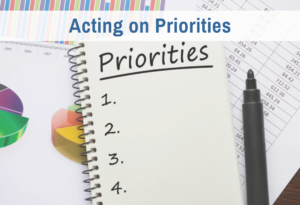If you’ve been following my work, you know that I recommend you motivate yourself entirely by values, not by threats. This means throwing out “duty” as a way to get yourself to do an important but unappealing task.
By a “duty,” I mean an out-of-context rule or absolute. If you do tasks on your “to do” list by telling yourself “I have to,” “I have no choice,” or “I’ll feel guilty if I don’t,” you are using the duty approach. The subtext is, “If I don’t do this, I am no damn good.” The implicit threat is that you will judge yourself to be a bad person if you don’t do this task.
This is mistaken and contradictory on many levels. For one thing, it presupposes that you are not a good person already, in which case, why would you care? For another, it assumes that you cannot be trusted to make a life-serving judgment about what you will do in this moment. That is the essence of free will. You always can take a constructive step, though sometimes it is not the same step you thought you should take a few minutes beforehand.
So why do people go by duty? It has a certain appealing simplicity.
When you go by duty, you don’t need to know the details. You don’t need to know the reason for your conclusion. You just need to know the task got on your list as #1. It doesn’t matter how or why. You just have to do it. So just do it. Don’t bother your pretty head with the details.
Of course, this is one way going by duty gets you in trouble. You put on some blinders, and won’t notice that the situation has changed. But 90% of the time, the situation has not changed, and the blinders shut out doubt and distraction and intensify the moral imperative, resulting in an impulse to “just do it.”
You need an impulse to act.
I learned this from experience when I was eliminating the duty approach from my life. A funny thing happened. Prioritized lists temporarily lost all of their power to motivate me. I could look at a list, identify the #1 priority task, and feel zero motivation to do it. I remember looking at a full list of “important” items, without feeling any motivation to do any item on the list.
Why?
Because I had rejected the general-purpose negative motivator, “do this or you’re no damn good,” without replacing it with a positive motivator.
There is no general-purpose positive motivator. It turns out that the value is often not obvious in a concrete task or a middle-range goal. To activate positive motivation, you need to connect the present task to an important value you want to achieve right now.
This takes more work than “just do it,” but it has many long-term benefits.
Sometimes you can simply examine the task and ask yourself, what’s the value I get from this? And you will see it. I see it when doing dishes. I will have a clear sink and counter. I am motivated to do dishes.
But often this is not true for tasks that are just a means to an end. The end-goal — say, a beautiful house —may be inspiring when you visualize it. But going through that pile of junk in the corner is not. If you want to motivate the mundane, boring, and unpleasant tasks that are a necessary means to achieving your wonderful ends, you need a reliable way to bring positive motivation to the task.
In these cases, I recommend you systematically look at this non-motivating task as the beginning of a means-end sequence that culminates in something you truly want. If you can’t connect it to something that truly matters to you, why are you doing it? If you see how it connects to what you truly want, that will give you ideas for how to get the payoff sooner rather than later.
I figured this out some years ago and wrote about it for my Thinking Lab. Here are some examples of how I clarified four tasks for which I felt zero motivation prior to figuring out the means-end sequence.
1. Article for Thinking Lab:
This turned out to be vague. The task was actually: Choose a topic, in order to prepare members for an upcoming class, in order to encourage them to come and participate, in order for them to get the most benefit from the program.
2. Marketing Prep:
This was vague, too. The task was actually: Make a list of everything I might do, in order to have some clue what I’m choosing between (clarity), so that I can schedule some particular items (pick a direction), so I can start working on it every day, so I can really grow my business.
3. Go through email:
Read each email, so I can find the hidden to-dos and disposition what I can, so I can clear away the fog of unknowns lurking there, so I can triage them, so I can ignore email tomorrow morning when I’m writing.
4. Work on book:
Work on chapter X, so that I can finish drafting chapter X in a week or so, so that I can complete the draft by DATE.
In two of these cases, the means-end sequence turned up a value that I could gain in the short term. Encouraging people to come to class and gaining clarity about the marketing tasks were clear values that motivated short-term action.
The email task might have been motivating, but it was focused on removing negatives: the fog of unknowns and the distraction of email. These are motivation by fear. If you want to motivate by values, you need to translate all threats into an identification of the value threatened. You need to know the value that you are really after. Here’s how I revised it:
3. Go through email: (Revised)
Read each email, so I can find the hidden to-dos and disposition what I can, so I can clear away the fog of unknowns lurking there (get the full context) so I can triage them, so I can ignore email tomorrow morning when I’m writing, so I can concentrate.
“Get the full context” is not too motivating to me. But I cannot tell you how many times I’ve been motivated to do a tedious task in order to ensure that I’ll be able to concentrate better on the book the next morning! It is a powerful positive motivator for me. Identifying the value that is truly at stake in taking the action makes all of the difference.
The book example had a different problem. It didn’t motivate because all its steps were abstract and dry. In other cases, I had switched the task from a vague assignment to a concrete task. That automatically triggered value words. There were no concretes or value words in the book means-end analysis, so I rewrote it:
4. Work on book: (Revised)
Work out [a point important to chapter X], so that I can explain it clearly, so that the book is easier to understand, so I can finish it sooner.
The prospect of gaining clarity about that specific point was motivating in the present. I could actually do that, and see my own progress, instead of trying to tie the work today to a theoretical deadline far in the future.
You know you have identified the means-end sequence specifically enough when:
- The task is concrete, not vague
- You see the task leads to a long-term goal that you care deeply about
- You see a value that you will gain in the short-term enroute to the long-term goal
Seeing the means-end sequence for the task takes a mental shift. But it pays off in many ways. Because you focus on values, you activate the full context instead of tunnel vision. Because you identify the long-term goal, you imbue the present task with deeper meaning. Because you work out the concrete means-end sequence, you see the immediate implications of taking action, including short-term benefits that you would not otherwise be aware of.
In the past, I would motivate myself to follow through by fear, using the duty premise. If I made a list of things I “had” to do, chose the most urgent, and reminded myself I “had” to do it, I usually felt compelled to do it. If I didn’t, I felt guilty.
Now, I motivate by values. I look at the task and see, concretely, how it is a means to an end I truly want, and will start to pay off in the short term. If it won’t pay off, I change the task or the plan to make sure it does. I usually feel motivated to do it. If I don’t, I have activated a full-value context, which is the best possible setup for figuring out a creative way to regroup.








0 Comments